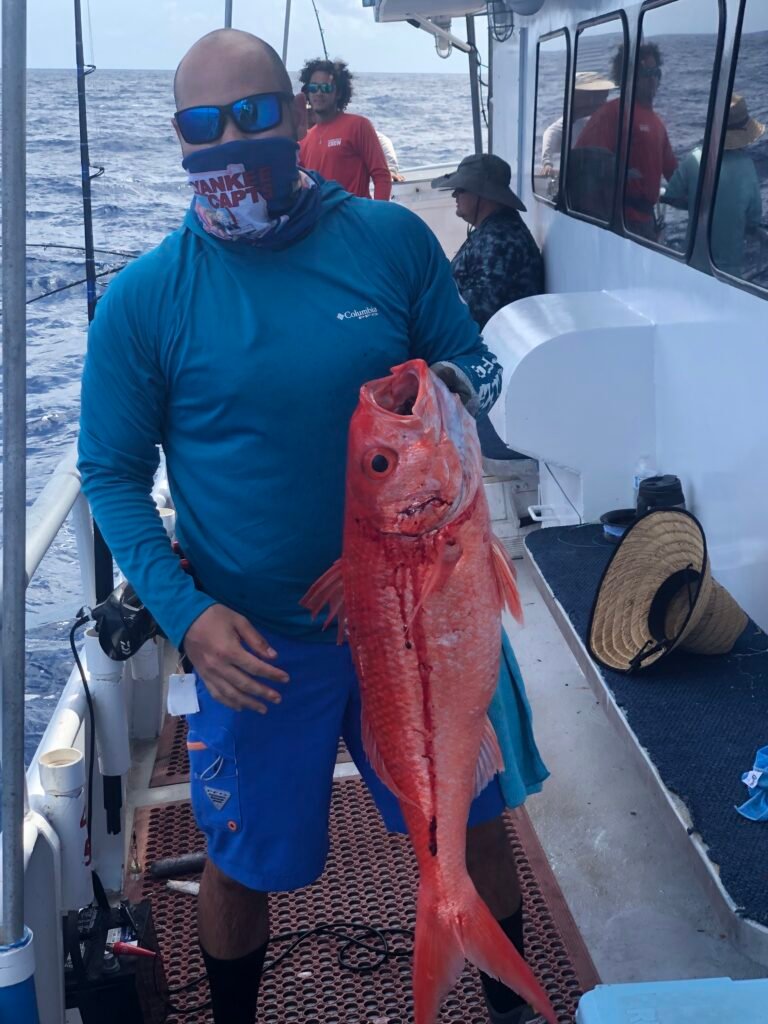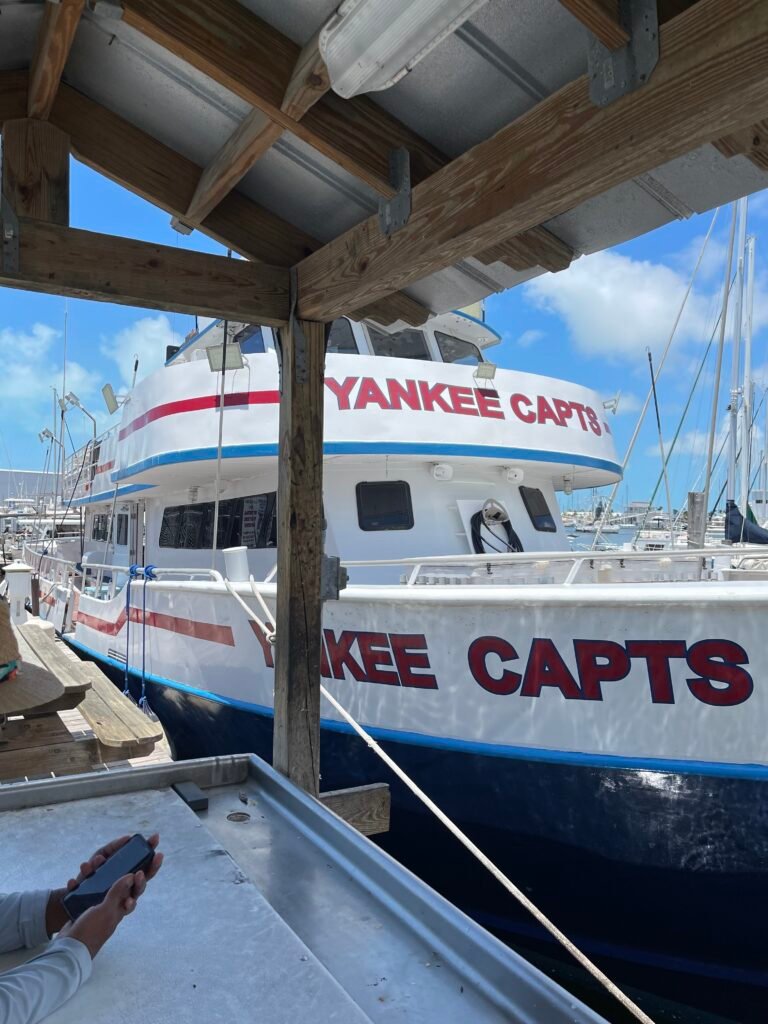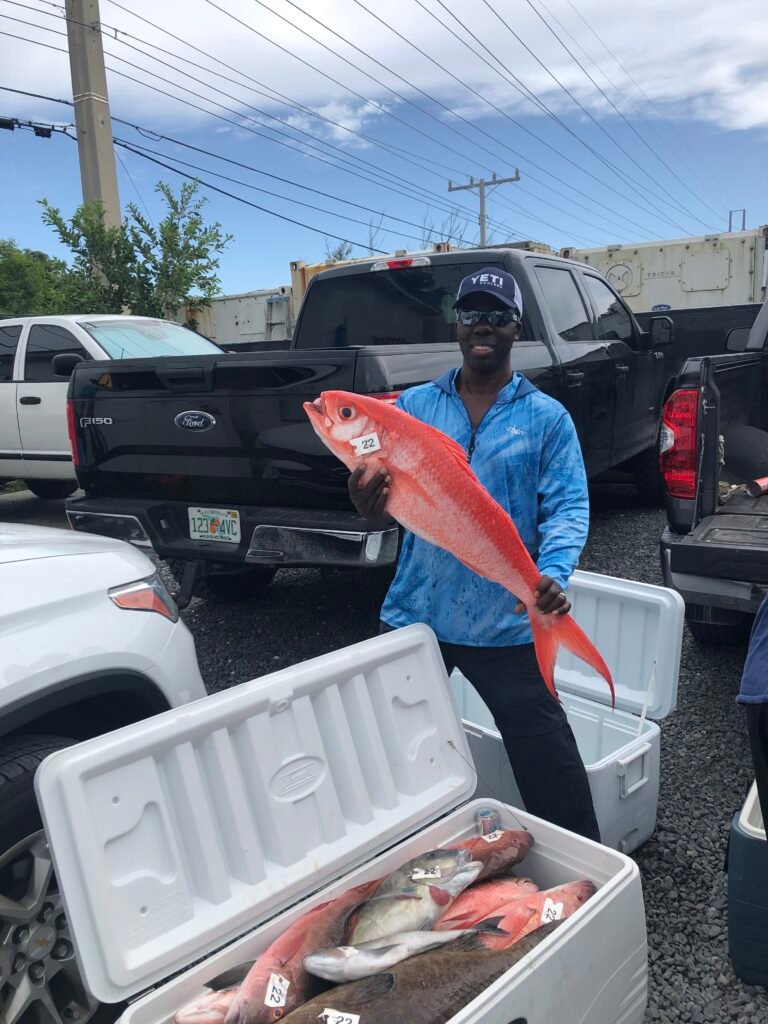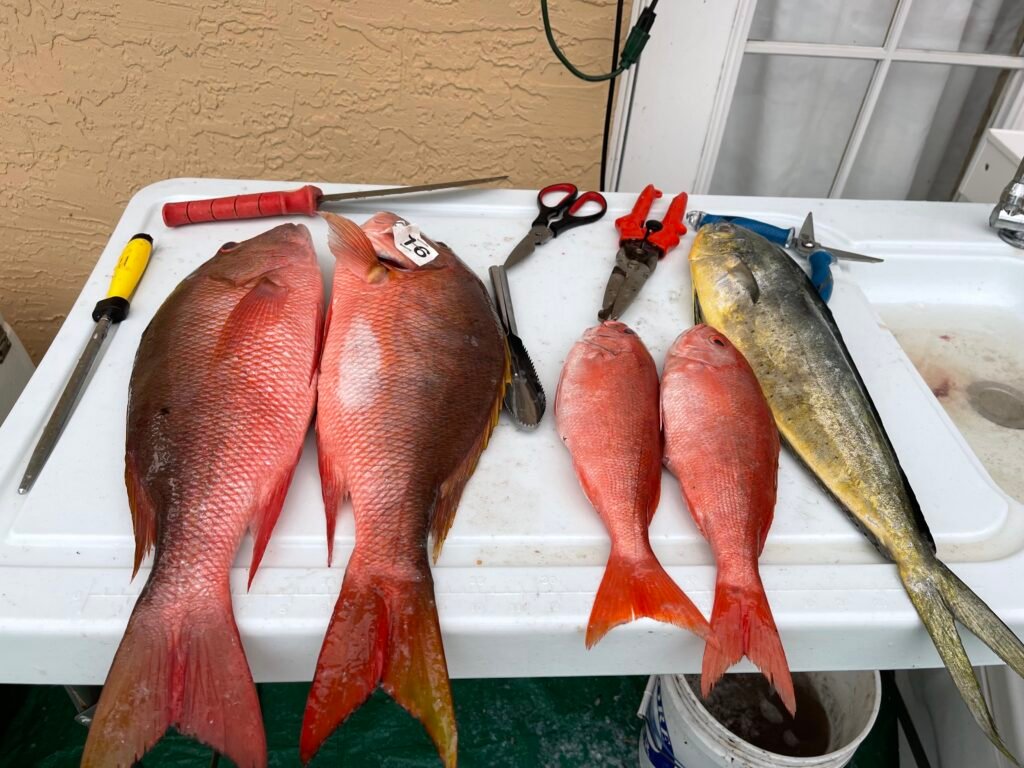Deep drop fishing with an electric reel aboard the Yankee Captain offers a more efficient and precise way to reach deep-water fish. Using an electric reel reduces the physical effort required, allowing anglers to fish deeper and longer without fatigue. This method enables better control over the line’s descent and retrieval, increasing the chances of a successful catch.

The Yankee Captain is equipped to handle deep water fishing, making it an ideal platform to use electric reels effectively. Anglers can target species that live at challenging depths with confidence, supported by the advanced gear on board.
This combination of technology and experience creates an accessible deep drop fishing experience for both novices and seasoned fishermen. It opens opportunities to explore new fishing grounds without the usual strain of traditional methods.
Overview of Deep Drop Fishing
Deep drop fishing involves fishing at significant depths, often exceeding 200 meters. It requires specialized gear and techniques to reach and attract deep-sea species. This method targets unique fish that are rarely caught by conventional fishing.
What Is Deep Drop Fishing
Deep drop fishing uses electric reels or heavy manual reels to drop baited hooks straight down into deep water. The line often reaches depths between 200 and 400 meters, targeting species that live near the ocean floor.
Electric reels help manage the heavy line and depth pressure, reducing the physical effort of hauling up heavy catches from these depths. Anglers typically use strong, abrasion-resistant lines and large jigs or bait to attract fish.
This technique requires patience and precision due to long drop times and slow retrieval speeds. It is often done from boats equipped for deep-sea fishing.
Targeted Species in Deep Drop Fishing
The common targets in deep drop fishing include Golden Tilefish, Grouper, Longtail Amberjack, and Swordfishjuveniles. These species inhabit the ocean floor or steep slopes where light and pressure conditions differ greatly from surface waters.
Several species are prized for their firm texture and flavor but require deep-water habitats to thrive. Tilefish and groupers are popular for both sport and commercial fishing.
Fish caught at these depths display unique adaptations to cold, high-pressure environments. Anglers who fish deep drop must prepare for species that vary in behavior and fight intensity.
Benefits of Deep Drop Fishing
Deep drop fishing opens access to fish species not reachable with shallow-water methods. It allows anglers to explore new fishing grounds that are often less pressured and more productive.
Using electric reels improves safety and efficiency by reducing physical strain. The ability to maintain line tension and control drift increases catch rates.
This method offers a different fishing experience, combining technical skill and patience, which is appealing to serious anglers. It also helps diversify catches in regions where surface stocks may be depleted.
Understanding Electric Reels
Electric reels use a motor to assist in line retrieval, reducing physical effort during deep drop fishing. They offer precise control over depth and speed and vary in power, line capacity, and features.
How Electric Reels Work
Electric reels operate by powering a small motor that winds the fishing line back on the spool. A control switch typically lets the angler raise or lower the line automatically. This mechanism allows for consistent retrieval speed and reduces fatigue, especially when fishing at depths of several hundred feet.
Inside the reel, sensors monitor line tension and depth. This information helps maintain steady playback and protects against line breakage. The motor draws power from onboard batteries, and some models include safety features like automatic shutoff when tension spikes.
Advantages Over Conventional Reels
Electric reels minimize the strain of hauling heavy fish or deep lines. Anglers can maintain more accurate depth control, improving catch rates on species near the seabed.
They also speed up deployment and retrieval, which increases efficiency during long trips. These reels handle heavier lines and larger weights better than manual reels, which is essential in deep drop fishing.
Unlike conventional reels, they reduce arm fatigue and allow for longer fishing sessions without physical exhaustion.
Selecting the Right Electric Reel
Choosing an electric reel depends on fishing depth, target species, and boat setup. Key specifications include motor power (measured in watts or amps), line capacity, drag strength, and speed settings.
Durability and water resistance are critical, as reels must withstand saltwater corrosion and pressure. Some reels offer digital displays for depth and line status, which help with precise fishing.
Budget also matters, with advanced models costing more but providing better reliability and features for extended deep drop fishing.
Aboard the Yankee Captain: An Overview

The Yankee Captain offers a combination of long-standing tradition and modern fishing technology. Its setup and staff are designed to support deep drop fishing, making the experience efficient and productive.
History and Reputation of Yankee Captain
The Yankee Captain is a well-established vessel based in Montauk, New York, with over two decades of experience in deep sea fishing. It has gained a strong reputation for targeting deep water species such as tilefish, wreckfish, and black sea bass.
The boat’s consistent focus on deep drop fishing has earned respect among anglers looking for specialized trips. Its track record shows reliable trips and solid catches, which appeals to both novices and seasoned fishermen.
The crew’s knowledge of local fishing grounds and seasonal patterns adds value to every outing. This experience translates into effective deep dropping techniques and understanding how to handle the electric reels during demanding conditions.
Onboard Amenities and Crew Expertise
The Yankee Captain accommodates up to 18 anglers with a spacious deck layout specifically designed for deep drop methods. It features multiple rod holders and a hydraulic reel setup area to help manage heavy gear and electric reels.
Inside, there is a climate-controlled cabin offering seating, safety equipment, and modern restrooms. The vessel also provides freshwater and charging stations to support anglers throughout the trip.
The captain and crew are trained to operate electric reels efficiently, assisting anglers with rigging, monitoring line tension, and handling catches. Their expertise minimizes downtime and improves success rates on deep drop targets.
They also prioritize safety protocols and maintain open communication during fishing, ensuring a smooth and focused experience in challenging offshore conditions.
Preparing for Your Deep Drop Fishing Trip
A successful deep drop fishing trip requires careful planning and the right equipment. Proper permits and adherence to regulations ensure compliance with local laws. Safety is critical due to the depth and conditions encountered aboard the Yankee Captain.
Essential Gear Checklist
The electric reel is the centerpiece, enabling efficient line management at extreme depths up to 1,000 feet. Anglers should pair it with 80-130-pound test braided line for strength and durability.
Other key items include:
- Deep drop rods designed for heavy loads and sensitive bites
- Terminal tackle such as heavy-duty swivels, snap weights (8-16 oz), and circle hooks
- A strong fighting belt or harness to reduce fatigue during long fights
- Protective gloves to handle tough fish and rough equipment
- Waterproof clothing and non-slip footwear for wet deck conditions
Proper battery backups and chargers for the electric reel’s power supply are essential. Bringing spare parts like extra leader material and hooks prevents downtime.
Licenses and Regulations
Before boarding the Yankee Captain, anglers must secure appropriate fishing licenses for federal and state waters. These vary by location and species targeted.
Deep drop trips primarily target bottom-dwelling species regulated under specific quotas and seasonal closures. Anglers must check size limits and catch caps set by NOAA and local fisheries management.
The captain usually provides updated guidance on current regulations. Compliance avoids fines or confiscation of gear. Registering any catches according to rules is also required.
Safety Considerations
Deep drop fishing involves specific risks like line tangles, equipment malfunctions, and sudden boat movements. Crew members brief anglers on safe handling of the electric reel and heavy tackle.
Life jackets must be worn whenever on deck. Cold water immersion suits should be available if there is a risk of falling overboard.
Proper hydration and sun protection remain important despite cooler ocean conditions. Anglers should be alert for seasickness and inform crew immediately if symptoms worsen.
Electrical cords and batteries must be secured to prevent slips or shocks. Communication devices and emergency signaling equipment are standard aboard the Yankee Captain.
Techniques for Deep Drop Fishing with Electric Reels
Effective deep drop fishing requires precise rigging, proper line management, and careful bait choice to attract bottom-dwelling species. Anglers must balance gear setup with targeted species’ feeding behaviors for consistent results.
Proper Rigging and Setup
Rigging starts with selecting strong, abrasion-resistant line, typically 80 to 130-pound test braided line for depths over 300 feet. The electric reel must be calibrated to maintain tension and prevent slack while dropping and retrieving.
A common rig uses a 12- to 16-ounce sinker to hold the bait near the bottom. Leaders should be fluorocarbon or monofilament, 4 to 6 feet long, to minimize visibility. Hooks range from size 6/0 to 10/0 depending on species targeted.
Setting drag correctly on the electric reel is crucial. It allows fish to pull line without breaking but provides enough tension for prompt hook sets. Many anglers add a swivel to reduce line twist during drift.
Bait Selection Strategies
Fresh bait increases catch rates for deep drop species like grouper and tilefish. Common baits include squid strips, whole sardines, or large shrimp, cut into chunks to withstand strong currents.
Anglers often use natural scents and blood to attract predators. Bait should be rigged to present naturally, using single large pieces or threaded strips on circle hooks to improve hook-up rates.
Bait must be durable enough to stay on hooks through long drops but not so dense it sinks too quickly past the strike zone. Regular bait replacement throughout the day ensures freshness and maximizes effectiveness.
Best Locations for Deep Drop Fishing Aboard Yankee Captain
The most productive depths and key fishing locations define success aboard the Yankee Captain. Knowing where to drop and what depths hold targeted species is essential for efficient deep drop fishing.
Productive Depth Ranges
Deep drop fishing aboard the Yankee Captain typically targets depths between 200 and 600 feet. These ranges align with oxygen-rich zones where many valuable species like blackbelly rosefish and shallow water tilefish congregate.
Fishing between 300-450 feet is often ideal for species like golden tilefish and blueline tilefish. Below 500 feet, anglers may encounter longspine thornyhead and Atlantic grenadier. Anglers should adjust depths seasonally, as thermoclines shift fish patterns.
Using the electric reel, maintaining consistent depth is easier, allowing multiple drops at exact productive strata. Monitoring bottom structure and temperature also helps pinpoint optimal depth bands.
Notable Fishing Spots in the Region
The Yankee Captain sails primarily off the coast of Massachusetts, targeting hotspots such as the Georges Bank and Nantucket Shoals. These areas offer varied bottom topography favorable for deep drop species.
The south side of Georges Bank, particularly near the 300-400 foot depth contours, is renowned for reliable catches of tilefish and rosefish. The rock piles around Nantucket Shoals attract dense populations of deepwater fish, making it a consistent choice.
Other notable locations include the Jeffreys Ledge and Hydrographer Canyon where rugged underwater terrain provides shelter and food sources for deepwater species. These sites require precise navigation aided by the boat’s GPS and sonar systems.
Tips for a Successful Deep Drop Fishing Experience

Preparation is essential to maximize fishing time and ensure safety. Efficient use of time and clear communication with the crew and other anglers improve the overall experience and yield.
Time Management on Board
Deep drop fishing requires patience and precision. Anglers should monitor the electric reel settings carefully to avoid overrun or damage when reaching depths over 1,000 feet.
It helps to organize gear and bait before dropping the line to minimize downtime. Checking weather and sea conditions early prevents surprises that can waste valuable fishing time.
Scheduling breaks and rotating duties among anglers keeps everyone alert and able to react quickly when a fish bites. Maintaining this rhythm ensures steady use of the electric reel without unnecessary delay.
Collaboration with Crew and Fellow Anglers
The crew manages the boat and assists with heavy equipment handling. Clear, concise communication with them ensures smooth deployment and retrieval of the electric reel.
Sharing tips and observations with fellow anglers helps in identifying productive fishing spots and adjusting techniques during the trip. Mutual respect speeds up line changes and reduces tangles.
Following crew instructions promptly enhances safety, especially when working with weighted rigs and deep lines. Cooperation keeps the fishing environment organized and more productive for everyone.
Sustainability and Conservation Practices
The Yankee Captain incorporates targeted techniques to minimize environmental impact during deep drop fishing. Particular attention is given to handling fish properly and adhering to strict fishing limits to support marine populations.
Ethical Catch-and-Release Methods
Proper handling reduces stress and injury to fish, increasing survival rates after release. The crew uses dehooking tools designed to remove hooks quickly without damaging fish mouths.
Fish are brought to the surface gently, avoiding rapid pressure changes that can cause barotrauma. When necessary, a venting tool is applied to release trapped gases safely.
Releasing fish promptly minimizes exposure to air, maintaining gill function. The crew also avoids dragging fish on deck, ensuring scales and slime coats remain intact.
Species Preservation and Limits
Yankee Captain strictly follows federal and state regulations on catch limits and size restrictions for targeted species. These rules are monitored and updated regularly to reflect population data.
Certain species, such as snowflake and golden tilefish, are caught within daily limits designed to prevent overfishing. The crew prioritizes species in healthier abundance and releases protected or undersized fish immediately.
Record-keeping of catches supports regulatory compliance and contributes to ongoing conservation efforts by local fisheries management agencies. This promotes long-term viability of deep-water species targeted during trips.
Post-Trip: Cleaning, Storing, and Cooking Your Catch
Efficiently managing the catch after a deep drop trip ensures quality and freshness. The process involves precise cleaning methods, appropriate storage techniques, and cooking options that highlight the flavors of deep-water fish.
Fish Cleaning Techniques

Cleaning deep-water fish immediately preserves texture and taste. Start by rinsing the fish in cold seawater to remove slime and debris.
Use a sharp fillet knife to scale, gut, and fillet the fish. Cutting along the backbone ensures minimal meat loss. Removing the dark bloodline in the fillet improves flavor and shelf life.
For species with thicker skin, like wreckfish, scaling may require more effort. Always keep the cleaned fish on ice or in cool storage after processing to slow bacterial growth.
Proper Storage Onboard
Storage focuses on temperature control and moisture management. Fish should be placed in an insulated cooler with plenty of crushed ice packed around it.
Drain meltwater regularly to prevent fish from sitting in excess water, which accelerates spoilage. Use a clean, food-safe container or sealed bags to avoid cross-contamination.
For longer trips, vacuum sealing is advisable to maintain freshness. Cold storage below 40°F (4°C) is essential to keep fish safe and maintain texture until arrival onshore.
Popular Cooking Methods

Deep drop fish typically have firm flesh suitable for grilling, baking, or pan-searing. Quick searing preserves moisture and enhances natural flavors.
Steaming is effective for delicate species, ensuring tenderness without oil. For oilier species, roasting with herbs and lemon adds balance.
Simple seasoning such as salt, pepper, and fresh herbs is often sufficient. Over-seasoning risks masking the subtle taste unique to deep-water catches.

Leave a Reply